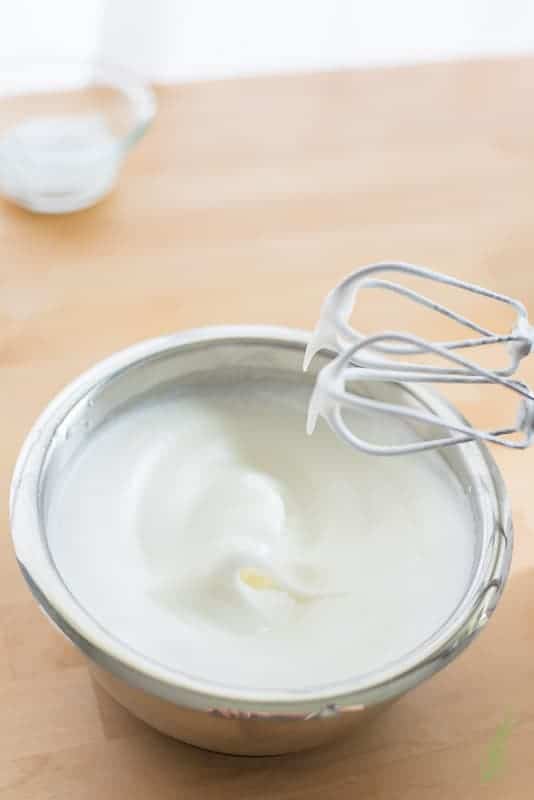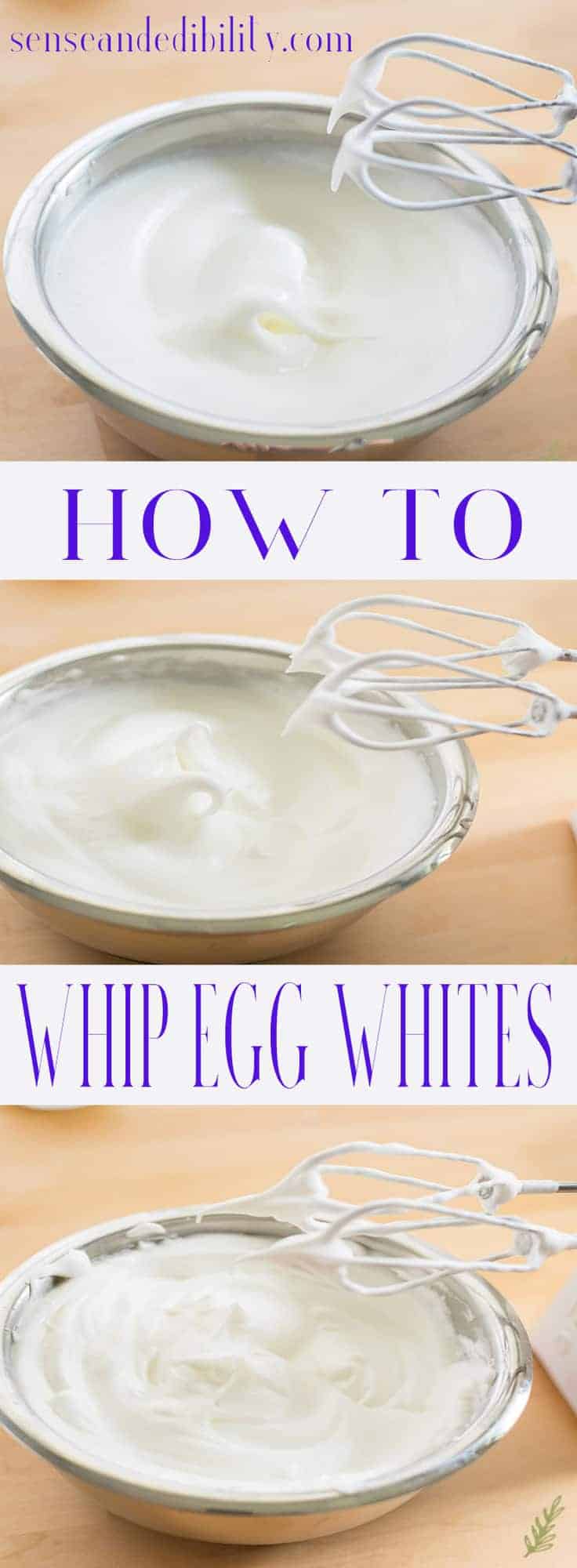You’ve read recipe instructions before that have told you to, “Whip the egg whites to stiff peaks.” And you’ve probably said to yourself, “If I knew what ‘whipping egg whites to stiff peaks’ meant, I’d feel so fulfilled.” You haven’t thought that? Oh, well…pretend like you have because I’m going to tell you all about whipping egg whites and their various peaks.
Knowing how to whip egg whites to their proper state is important in both the culinary and pastry world. Under-whipped egg whites can be the bane of many a pastry chef’s existence; I know they have been for me multiple times. Whipped egg whites are what is commonly used to leaven cakes (which is precisely what I’ve done for the sponge cake here). I’ve used whipped egg whites to give a lighter, fluffier texture to waffles and pancakes; and, of course, they can be sweetened and turned into meringues. This is just a handful of ways whipping egg whites can benefit you in the kitchen.
People get in a kerfuffle when they read “whip to [insert stage here]”, but it’s straightforward, and actually pretty easy to do. I’m going to show you the best ways to whip your whites with the most success. When whipping egg whites, your forcing air into the protein-packed albumen. This, in turn, causes them to stretch and expand around the H2O in the whites. The longer you whip, the more they expand, thus taking you from a light foam to a thick, glossy stiff peak.
One lesson most pastry apprentices, or culinary students, will never forget is their first attempt at whipping egg whites. My pastry chef instructor ensured we whipped to a very stiff peak by making us hold our inverted mixing bowl over our heads. If you ended up with a headful of egg whites, you failed the test. Prime motivation, is it not? We also had to whip our egg whites by hand. Ever see Popeye’s forearms? He had to have been a pastry chef. It hurts, y’all.
Thankfully, I won’t ask you to hold your bowls aloft, nor will I tell you to whip by hand.
The first thing you need to be successful with whipping egg whites are fresh eggs. I know that’s relative considering few of us have chickens out back laying eggs. Don’t use eggs that you bought two weeks ago, is all I’m saying. The fresher the better, because the proteins in the egg whites are more acidic. Older eggs have lost their acidity and won’t whip as full.
The second thing you need for full-on voluminous egg whites is an oil-free environment in which to whip them. Your hands (you’ll see why in a minute), your beaters, and your mixing bowl should be squeaky clean and free of any traces of oil. Oil inhibits the egg whites from whipping properly, or at all. Whipping egg whites in a plastic bowl is a no-no because most plastic bowls, no matter how clean you think they are, will contain traces amounts of residual oil. Use a metal, glass, or ceramic bowl whenever you need to whip egg whites. Make extra-sure your bowl is free of oil by rubbing it down with a lemon half. The acid in the lemon juice will break down any oils. Just wipe clean and dry afterwards.
Having said all of that, I’ll be completely transparent and tell you that there have been a handful of times where I accidentally got a drop, or two, of yolk into my whites. I hate to waste money or food, so I whipped them anyway. They still whipped to a stiff peak, but it took much longer than it normally did. So, while I encourage you to avoid getting any yolk into the bowl- a little bit (a drop or two) won’t kill the vibe. It’ll just take the vibe a little longer till it’s poppin’. Hence, the reason we want to avoid fat if at all possible.
Now that we have all these different components in place, we’re ready!
First thing’s first: break the egg into your clean, dry hand. Yes, your hand. There’s no room for squeamishness here. Your hand is smooth, unlike the jagged edges of the egg shell you just broke open. Doing that age old technique of shifting the egg back and forth between the shell halves is a great way to puncture the yolk. Guess what that yolk is full of? Fat.
Once you’ve deposited the whole egg into your clean hand, separate your fingers ever so slightly to allow the egg whites to slip through and into the bowl. Deposit the egg yolk into a separate bowl, and continue like this until you have the egg whites you need. Fun fact: one large egg white weighs one ounce. I’m totes random, I know.
Once you have your egg whites separated, allow them to sit. Warm egg whites whip higher than their cold counterparts. Allowing them to sit out at room temperature for an thirty minutes to an hour will give you great volume on your egg whites.
When your egg whites have warmed up, begin whipping them. Use an electric hand mixer and start the process on a low speed. Can you use a whisk and whip by hand? Yes. Will you hate me afterwards if you do? Again, yes. Electric hand mixers are where it’s at for this technique.
Once your egg whites begin to look foamy, increase the mixer’s speed to medium-high. Now, gradually add the sugar that’s called for in your recipe. Gradually adding the sugar prevents the egg whites from deflating while you’re whipping. Dumping the sugar into the egg whites will compromise the integrity of the foam and can, potentially, inhibit the egg whites from whipping to the full, glossy peaks you want.

Whipping egg whites for three to four minutes will yield firm peaks. These egg whites will hold their shape much better than soft peak, but will still fold over slightly when the beater is removed. You’re on the right track!!
Now that we have been whipping our egg whites on medium-high speed for five to six minutes, we have reached stiff peak stage. When removed from the bowl, our egg whites stand straight up from the beaters. No flopping whatsoever…
We could even invert our bowl if we wanted to! Now, stop whipping! Egg whites should be stiff, yet still glossy and fluffy. Over-mixing the egg whites will break them and cause them to become chunky and foamy-looking. IF that happens, which it won’t because you listen to me, add another room temperature egg white and whip again. This will balance out the mix and salvage all of your hard work.
You’ve just whipped your egg whites to stiff peaks! That makes you a freaking rockstar- okay? Now, pin this and share your newfound chef skill with your friends and family!
Now that your an egg white whipping boss,
try your hand at these recipes:
Swiss Meringue
S’mores Cheesecake
**This post contains affiliate links. To find out what that means to you, please read my disclosure page**













This TOTALLY has me wanting to make a lemon meringue pie! It’s one of those things that seems so difficult (although even if you mess up, it’s still delicious!). I’m going to give your instructions a go!
I’m working on a citrus meringue pie recipe this week, Caitlin!! Great minds think alike!
This is a great post to help people! Such a great skill and know how to have to create yummy food!!
I’m glad it will help others, Julie!
Love this! My dad actually taught me this as a kid:) oh the memories!
What a great Dad you have, Bre!
I’m so glad that I stumbled upon this post! I have totally failed at whipping eggs in the past! Taking your tips to try next time!
Awesome, Amber! Glad I could help!
Ok definitely learning how to do this so I can make that s’mores cheesecake! HOLY moly that looks good!
Oh, it’s super-indulgent, Adriana. You’ll love it!